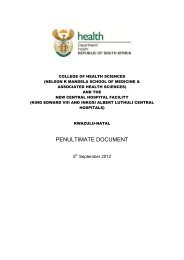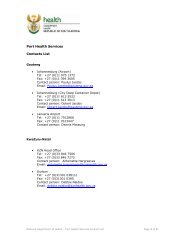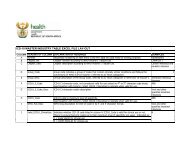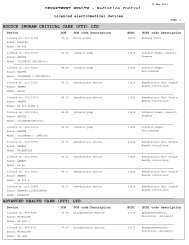National Norms and Standards relating to Environmental Health
National Norms and Standards relating to Environmental Health
National Norms and Standards relating to Environmental Health
Create successful ePaper yourself
Turn your PDF publications into a flip-book with our unique Google optimized e-Paper software.
c) Documents outlining prevention, surveillance <strong>and</strong> control of public health risks onboard should beavailable.SECTION 5:MONITORING OF WATER QUALITY ON BOARD SHIPImproperly managed water is an established route for infectious disease transmission on ships. Theimportance of water was illustrated in the review of more than 100 outbreaks associated with shipsundertaken by Rooney et al. (2004), in which one fifth were attributed <strong>to</strong> a waterborne route. Mostwaterborne outbreaks of disease on ships involve ingestion of water contaminated with pathogensderived from human or other animal excreta. Illnesses due <strong>to</strong> chemical poisoning of water have alsooccurred on ships, although chemical incidents are much less commonly reported than microbial ones.Even if the water at the port is safe, this does not ensure that it will remain safe during the transfer <strong>and</strong>s<strong>to</strong>rage activities that follow.1. Ships must be loaded with potable water obtained only from water sources <strong>and</strong> suppliers that providepotable water <strong>and</strong> that conforms <strong>to</strong> SANS 241 in terms of chemical, microbial, physical <strong>and</strong>radiological quality, <strong>and</strong> must conform <strong>to</strong> the specifications as per WHO Guide <strong>to</strong> Ship Sanitation <strong>and</strong>the H<strong>and</strong>book for Inspection of Ships <strong>and</strong> Issuance of Ship Sanitation Certificates;2. Water transported <strong>to</strong> the ship must comply with the specifications of the SANS 241 with regards <strong>to</strong> itschemical, microbiological <strong>and</strong> physical quality.3. Water provided on board an aircraft must take in<strong>to</strong> consideration the number of travelers <strong>and</strong> theintended use (i.e. preparation of beverages, h<strong>and</strong> washing, onboard showering facilities, cleaning ofutensils <strong>and</strong> work areas etc.);4. Tanks used for s<strong>to</strong>ring water must be kept clean <strong>and</strong> protected against contamination;5. Water moni<strong>to</strong>ring /sampling must be well documented <strong>and</strong> records <strong>to</strong> be kept.6. A water supply delivered <strong>to</strong> ports must be suitable for distribution <strong>and</strong> consumption without furthertreatment as necessary <strong>to</strong> maintain water quality in the distribution system.7. Potable water in the ship, port <strong>and</strong> distribution system must comply with the requirements as outlinedin the WHO. Guide <strong>to</strong> ship sanitation, 3 rd edition <strong>and</strong> as set out in the SANS 241.8. Ships should have risk management plans in place. Each entity for the ship water supply; shore waterdistribution system; transfer <strong>and</strong> delivery system <strong>and</strong> ship water system should prepare <strong>and</strong>implement a risk management plan for that part of the process.9. PHO must test drinking water supply <strong>to</strong> the ships <strong>and</strong> the ports regularly for fitness of humanconsumption both on an operational level <strong>and</strong> on compliance level.10. PHOs should also develop <strong>and</strong> implement Water Quality Moni<strong>to</strong>ring Programmes for ship <strong>and</strong> portwater.11. WQMP should be implemented for compliance moni<strong>to</strong>ring <strong>and</strong> audit sampling purposes. The saidprogrammes should highlight the “objectives” for the sampling, location “where” <strong>to</strong> sample <strong>and</strong>assess the detemin<strong>and</strong>s “what” <strong>to</strong> be assessed, <strong>and</strong> the frequency “how often” <strong>to</strong> sample, for thepurpose of moni<strong>to</strong>ring of all water from catchment <strong>to</strong> consumer which has the potential <strong>to</strong> impacthuman health following use.12. PHOs should only conduct compliance moni<strong>to</strong>ring from pre-determined representative samplingpoints <strong>and</strong> at the user points as outlined in the WQMPs.13. PHOs should moni<strong>to</strong>r water supply, in accordance <strong>to</strong> deliberate water quality moni<strong>to</strong>ring programmesfor the purpose of quality assurance <strong>and</strong> <strong>to</strong> satisfy a quest <strong>to</strong> ensure optimum public health.14. PHOs should ensure that the WQMP is strictly followed <strong>and</strong> implemented; hence proper water qualitymoni<strong>to</strong>ring records should be kept at all times.15. PHOs should only use the SANAS 17025:2005 accredited labora<strong>to</strong>ries or Department of WaterAffairs (DWA)-approved labora<strong>to</strong>ries per method of analysis for analysis of samples, <strong>to</strong> ensurecredible results.16. PHOs acquaint themselves with <strong>and</strong> have an underst<strong>and</strong>ing of the ship drinking-water supply <strong>and</strong>transfer chain <strong>to</strong> be able <strong>to</strong> illustrate the points at which the water can become contaminated en route<strong>to</strong> the taps on board.17. Regular moni<strong>to</strong>ring must be done for each parameter <strong>to</strong> ensure maintenance of safe water quality18. The operational limits, moni<strong>to</strong>ring of water quality <strong>and</strong> instituting of corrective action where requiredfor the water in the distribution system must be in accordance with the requirements as specified inWHO. Guide <strong>to</strong> ship sanitation.DOH. <strong>Norms</strong> <strong>and</strong> st<strong>and</strong>ards for environmental health in South Africa Feb 2013 87


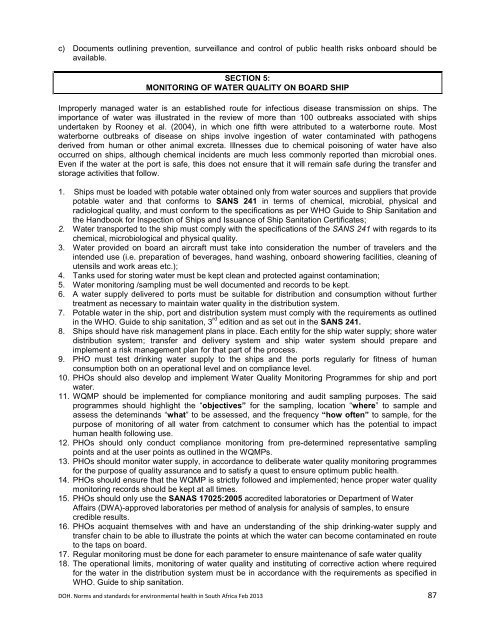
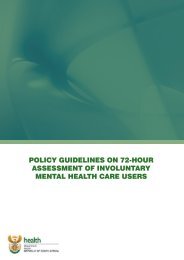
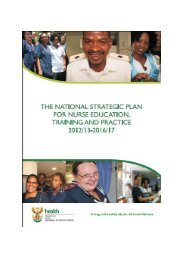
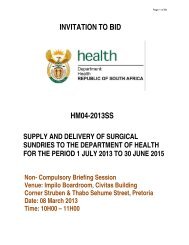
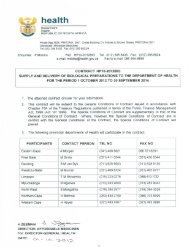
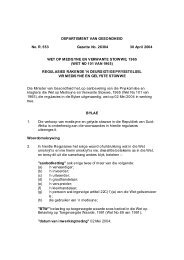
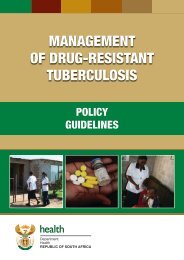
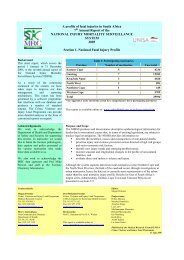
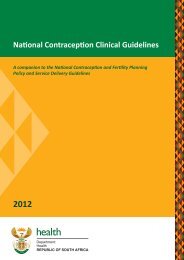
![A monograph of the management of postpartum haemorrhage [2011]](https://img.yumpu.com/15578784/1/184x260/a-monograph-of-the-management-of-postpartum-haemorrhage-2011.jpg?quality=85)
